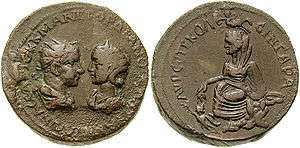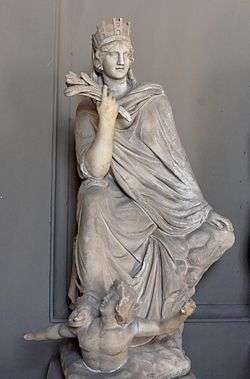Tyche
Tyche (/ˈtaɪkiː/; Greek: Τύχη, Túkhē, 'Luck'; Ancient Greek: [tý.kʰɛː];[1] Modern Greek: [ˈti.çi]; Roman equivalent: Fortuna) was the presiding tutelary deity who governed the fortune and prosperity of a city, its destiny. In Classical Greek mythology, she is the daughter of Aphrodite and Zeus or Hermes. The Greek historian Polybius believed that when no cause can be discovered to events such as floods, droughts, frosts, or even in politics, then the cause of these events may be fairly attributed to Tyche.[2]
| Tyche | |
|---|---|
Presiding tutelary deity governing the fortune and prosperity of a city, its destiny | |
 Polychrome marble statue depicting Tyche holding the infant Plutus in her arms, 2nd century CE, Istanbul Archaeological Museum | |
| Gender | Female |
| Parents | Aphrodite and Zeus or Hermes |
| Roman equivalent | Fortuna |
Increasingly during the Hellenistic period, cities venerated their own Tychai, specific iconic versions of the original Tyche. This practice was continued in the iconography of Roman art, even into the Christian period, often as sets of the greatest cities of the empire. By then the Tyche were probably seen as merely personifications of the city with little religious significance.
Genealogy
In literature, Tyche might be given various genealogies, as a daughter of Hermes and Aphrodite, or considered as one of the Oceanids, daughters of Oceanus, and Tethys, or of Zeus.[3] She was connected with Nemesis[4] and Agathos Daimon ("good spirit").
Worship
Tyche was uniquely venerated at Itanos in Crete, as Tyche Protogeneia, linked with the Athenian Protogeneia ("firstborn"), daughter of Erechtheus, whose self-sacrifice saved the city.[5] In Alexandria the Tychaeon, the Greek temple of Tyche, was described by Libanius as one of the most magnificent of the entire Hellenistic world.[6]
Stylianos Spyridacis [7] concisely expressed Tyche's appeal in a Hellenistic world of arbitrary violence and unmeaning reverses: "In the turbulent years of the Epigoni of Alexander, an awareness of the instability of human affairs led people to believe that Tyche, the blind mistress of Fortune, governed mankind with an inconstancy which explained the vicissitudes of the time."[8]
Depictions

Tyche appears on many coins of the Hellenistic period in the three centuries before the Christian era, especially from cities in the Aegean. Unpredictable turns of fortune drive the complicated plotlines of Hellenistic romances, such as, Leucippe and Clitophon or Daphnis and Chloe. She experienced a resurgence in another era of uneasy change, the final days of publicly sanctioned Paganism, between the late-fourth-century emperors Julian and Theodosius I, who definitively closed the temples. The effectiveness of her capricious power even achieved respectability in philosophical circles during that generation, although among poets it was a commonplace to revile her for a fickle harlot.[9]
In Greco-Roman and medieval art Tyche was depicted as carrying a cornucopia (horn of plenty), an emblematic gubernaculum (ship's rudder), and the wheel of fortune, or she may stand on the wheel, presiding over the entire circle of fate.
The constellation of Virgo is sometimes identified as the heavenly figure of Tyche,[10] as well as other goddesses such as Demeter and Astraea.
Greco-Roman Tychai

In late Roman sets the figures, usually four, represented the Tychai of Rome, Constantinople, Alexandria, and either Antioch (more usual, as in the Esquiline Treasure of about 380 AD) or Trier, as in the Calendar of 354. The Tychai may be seen wearing a mural crown (a crown like the walls of the city).
- Tyche of Rome
 Tyche from the Esquiline Treasure
Tyche from the Esquiline Treasure
The Tyche of Rome was represented in military costume.[11]
- Tyche of Constantinople
- Base of a statue
 Tyche from the Esquiline Treasure
Tyche from the Esquiline Treasure
The attributes of the Tyche of Constantinople included a cornucopia.[11]
- Tyche of Alexandria
 Tyche from the Esquiline Treasure
Tyche from the Esquiline Treasure
The Tyche of Alexandria carried sheaves of corns and stepped on the bow of a ship.[11]
- Tyche of Antioch
- Provincial bronze coin of Trebonianus Gallus (reverse)
 Roman copy of a bronze by Eutychides, Galleria dei Candelabri, Vatican Museums
Roman copy of a bronze by Eutychides, Galleria dei Candelabri, Vatican Museums
 Tyche from the Esquiline Treasure
Tyche from the Esquiline Treasure
Several artefacts feature the Tyche of Antioch with a male swimmer personifying the Orontes River at her feet.
References
- Ancient Greek pronunciation
- Polybius. The Rise Of The Roman Empire, Page 29, Penguin, 1979.
- Pindar, Twelfth Olympian Ode.
- As on an Attic amphora, fifth century BCE, Antikensammlung Berlin, illustrated at Theoi.com.
- Noted by Spyridakis, who demonstrated that earlier suggestions of a source in Fortuna Primigenia of Praeneste was anachronistic.
- Libanius, in Progymnasmata 1114R, noted by Spyridakis 1969:45.
- University of California Davis faculty: Stylianos Spyridakis Archived 2010-05-16 at the Wayback Machine
- Spyridakis, Stylianos. "The Itanian cult of Tyche Protogeneia", Historia: Zeitschrift für Alte Geschichte 18.1 (January 1969:42-48) p. 42.
- C. M. Bowra, "Palladas on Tyche" The Classical Quarterly New Series, 10.1 (May 1960:118-128).
- DK Multimedia: Eyewitness Encyclopedia, Stardome, Virgo: miscellaneous section
- The British Museum, London, quoted by Osama Shukir Muhammed Amin, "Tyche Furniture Ornaments", 2016, Ancient.eu
External links
